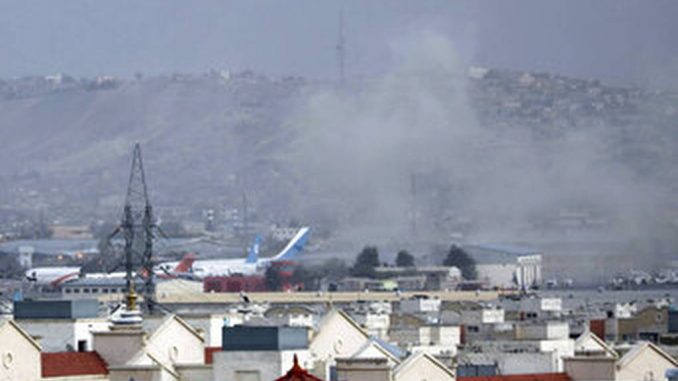
The moment of the choosing was Friday night.
A day after 13 U.S. service members were killed in the bloodiest single day for Americans since 2011, the U.S. carried out a drone strike, taking out a planner for the group claiming responsibility, according to U.S. Central Command.
Thursday afternoon, President Joe Biden, heavily criticized for the deadly chaos in Kabul, vowed payback.
“I’ve ordered my commanders to develop operational plans to strike ISIS-K assets, leadership and facilities,” Biden said in a White House address. “We will respond with force and precision at our time, at the place we choose, in a moment of our choosing.”
The weapon of choice was a drone.
“U.S. military forces conducted an over-the-horizon counterterrorism operation today against an ISIS-K planner,” said Navy Capt. Bill Urban, the CENTCOM spokesman, in a statement.
“The unmanned airstrike occurred in the Nangahar Province of Afghanistan,” Urban said. “Initial indications are that we killed the target. We know of no civilian casualties.”
RELATED
:quality(70)/cloudfront-us-east-1.images.arcpublishing.com/mco/JDFXKCSJQ5GYPAQ6ZWSI55PGE4.jpg)
Urban did not immediately respond to a question about who that planner was or the connection to Thursday’s deadly attack that killed 11 Marines, a sailor, a soldier and more than 170 Afghans.
Another 18 U.S. service members were wounded in that attack, officials say.
Nangarhar province, along the Pakistan border, has been an ISIS-K stronghold beginning in 2015.
Much has been made of the Pentagon’s cooperative efforts over the last two weeks with a longtime foe in a protracted conflict that cost more than 2,400 U.S. troop deaths.
Friday, Maj. Gen. Hank Taylor told reporters that force protection efforts in the wake of the deadly attack includes “communication with the Taliban, in terms of how they are executing their checkpoint operations and communication.”
But the U.S. and Taliban fighting ISIS-K at the same time is nothing new.
Thanks to U.S. and Afghan airstrikes, combined with Taliban ground operations, ISIS-K lost more than half its fighters, according a February 2020 Pentagon inspector general report.
Officials with U.S. Forces Afghanistan at the time said it was hard to estimate the number of remaining ISIS fighters in the country. However, in September 2019, the terrorist group was capable of fielding between 2,000 and 5,000 fighters, the IG report detailed.
ISIS-K lost its home turf in Nangarhar Province in November, forcing 300 of the jihadi fighters to surrender to Afghan forces.
But the terrorist group continued to limp on despite intense military pressure against it between September 2019 and February 2020.
U.S. officials acknowledged ISIS’ collapse in Nangarhar was also a result of sustained ground operations carried out by America’s long-time foe in Afghanistan, the Taliban.
“Following months of sustained pressure from both the United States and the Taliban, ISIS-K militants in Nangarhar surrendered en masse,” the IG report details.
That was after then-President Donald Trump dropped the “mother of all bombs” on an ISIS-K tunnel complex in April 2017. The strike killed about 90 ISIS-K militants, the Associated Press reported at the time.
It was the first combat use of a bomb officially called a GBU-43B, or Massive Ordnance Air Blast bomb. The 11-ton bomb wiped an ISIS defensive position, U.S. military officials said at the time. Former Afghan President Hamid Karzai called the use of the weapon “an immense atrocity against the Afghan people.”
In November 2019, Afghan President Ashraf Ghani said ISIS had been “obliterated” in Afghanistan.
Trump touted the success of operations against the Islamic extremist group during a 2019 Thanksgiving Day surprise visit to American troops at Bagram Airfield. There, he detailed how U.S. forces were “wiping” out ISIS militants “left and right.”
But they never were wiped out.
According to UN figures, ISIS-K launched 77 attacks in the first four months of this year, according to CNN.
The group was especially deadly to civilians in Afghanistan, including several suicide bombings in the capital, Kabul.
And they are suspects in car bombing attack outside a girls’ high school in May, that took at least 85 lives.
Thursday in Kabul, they came at a withdrawing U.S. with a vengeance.
Howard Altman is an award-winning editor and reporter who was previously the military reporter for the Tampa Bay Times and before that the Tampa Tribune, where he covered USCENTCOM, USSOCOM and SOF writ large among many other topics.



Be the first to comment